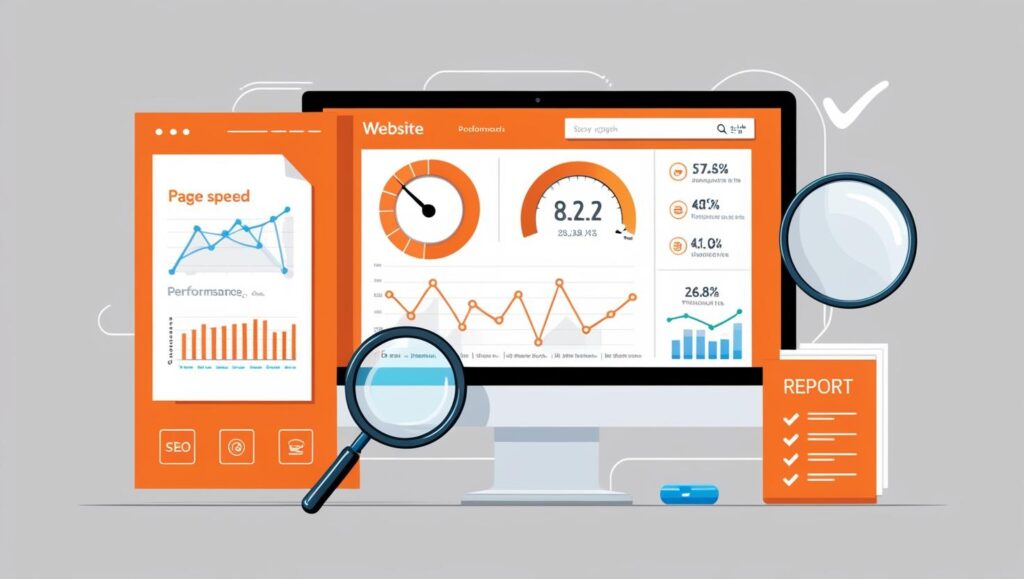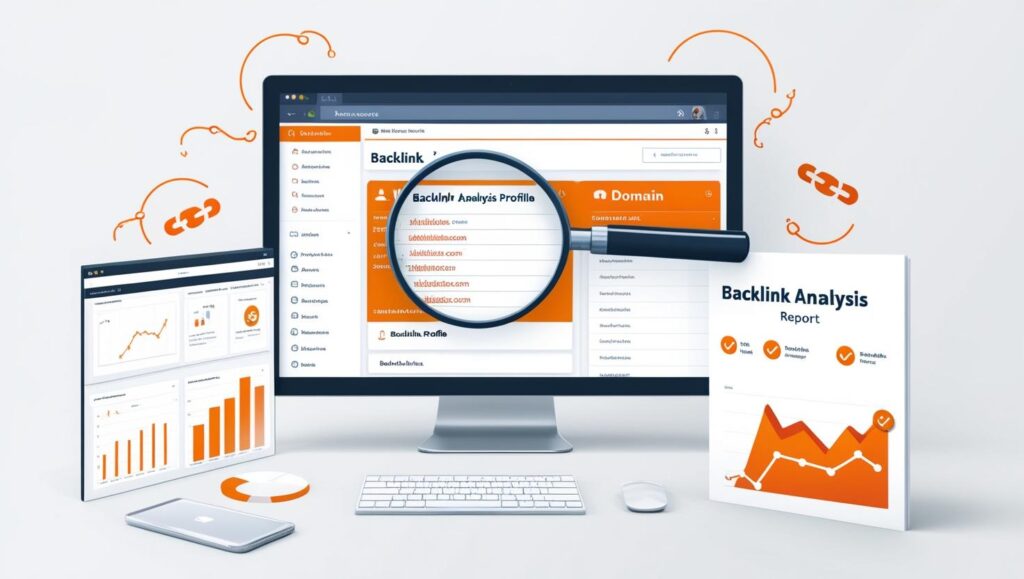Introduction
In the ever-changing world of search engine optimization (SEO), conducting a comprehensive SEO audit is crucial for ensuring that your website is performing optimally and achieving its full potential in search engine rankings. Whether you’re a seasoned SEO professional or just starting, performing an SEO audit is a vital task that allows you to identify areas of improvement, rectify issues, and enhance your site’s visibility.
This guide will walk you through how to perform a complete SEO audit in 10 simple steps. By the end, you’ll have a clear action plan to optimize your website and improve its ranking in search engines.
Step 1: Analyze Your Website’s Performance

The first step in an SEO audit is to analyze your website’s overall performance. This includes checking how quickly your website loads, as well as how it performs on different devices and browsers. A slow-loading website can severely impact user experience and affect your search engine ranking. Google’s Core Web Vitals are essential for measuring the performance of your site.
To begin, use tools like Google PageSpeed Insights, GTMetrix, or Pingdom to test your website’s loading time. These tools will provide you with valuable insights into factors such as:
- Page load time
- Time to first byte
- Largest contentful paint (LCP)
- First input delay (FID)
Google recommends that websites should load in under 3 seconds. If your site takes longer, it’s time to consider optimizing images, reducing server response time, and minimizing unnecessary scripts.
Step 2: Check Your Website’s Mobile-Friendliness
With mobile search traffic now surpassing desktop traffic, Google has shifted to a mobile-first indexing approach, meaning your website’s mobile version is the primary factor that affects your rankings. It is essential that your website is mobile-friendly and offers a smooth user experience on mobile devices.
You can check if your website is mobile-friendly by using Google’s Mobile-Friendly Test tool. If your website isn’t optimized for mobile, you’ll want to ensure it’s responsive, meaning the layout and content adjust to fit the screen size of any device.
Step 3: Review Your Website’s On-Page SEO Elements
On-page SEO refers to the optimization of individual web pages to rank higher and earn more relevant traffic. This step involves reviewing key on-page SEO elements, including:

- Title Tags: Each page should have a unique title tag that includes your target keyword. Title tags should be between 50-60 characters to avoid truncation in search results.
- Meta Descriptions: Meta descriptions should summarize the content of the page in 155-160 characters, providing a compelling reason for users to click through from search results.
- Headers (H1, H2, H3, etc.): Your headers should be structured correctly, with the H1 tag reserved for the main title and subsequent header tags used for subheadings. Including target keywords in headers helps search engines understand the content hierarchy.
- Content Optimization: Ensure that your content is high-quality, informative, and optimized for your target keywords. Avoid keyword stuffing, and aim for a natural flow that provides value to the user.
- Image Alt Text: Images should be optimized with descriptive alt text that includes relevant keywords. This helps search engines understand the image content and improves accessibility for visually impaired users.
Step 4: Perform a Backlink Analysis
Backlinks are one of the most important factors in SEO. They signal to search engines that your website is credible and authoritative. A healthy backlink profile can significantly improve your search engine rankings.

Use tools like Ahrefs, Moz, or SEMrush to perform a backlink audit. Look for the following:
- Quantity and Quality of Backlinks: Ensure that your website has high-quality backlinks from reputable sites in your niche. Disavow any spammy or toxic backlinks.
- Anchor Text Distribution: Review the anchor text used for backlinks. It should be varied and natural, rather than overly optimized with exact-match keywords.
- Broken Backlinks: Identify any broken backlinks pointing to your site and attempt to recover them by reaching out to the website owners or implementing 301 redirects.
Step 5: Evaluate Your Website’s URL Structure
URL structure plays an essential role in both SEO and user experience. Search engines and users should be able to easily interpret your URLs.
Best practices for URL structure include:
- Short and Descriptive URLs: Keep URLs short, descriptive, and easy to read. Ideally, they should include the target keyword for the page.
- Avoid Special Characters: Avoid using special characters like &, %, or $ in URLs as they can be difficult for search engines to understand.
- Use Hyphens for Word Separation: Use hyphens (-) instead of underscores (_) to separate words in a URL. This makes it easier for both search engines and users to understand.
Ensure that your URLs follow these best practices, and consider creating a clean, logical structure for your website’s content.
Step 6: Perform a Content Audit
Content is a critical component of SEO. During a content audit, you’ll identify which pages and posts on your website are underperforming and need improvement.
Start by reviewing your site’s content for the following:
- Keyword Optimization: Ensure your pages are targeting relevant and high-search volume keywords. Use tools like Google Keyword Planner, Ahrefs, or SEMrush to identify keyword opportunities.
- Content Gaps: Identify gaps in your content and areas where you could create new, valuable content to meet the needs of your audience.
- Content Quality: Update any outdated or low-quality content. Ensure all content is unique, well-researched, and provides value to your readers.
- Internal Linking: Use internal links to guide visitors to related content on your website, which helps both users and search engines navigate your site.
Step 7: Check for Duplicate Content
Duplicate content can cause issues for SEO, as it confuses search engines about which version of the content should rank. It’s essential to identify and address duplicate content on your site.
Use tools like Copyscape or Siteliner to check for duplicate content. If you find any, consider consolidating similar content into one comprehensive page or using canonical tags to tell search engines which version of a page is the primary one.
Step 8: Audit Your Site’s Technical SEO
Technical SEO ensures that search engines can crawl and index your website without issues. A technical audit typically involves checking several critical elements, including:

- XML Sitemap: Ensure your website has an XML sitemap that is up-to-date and submitted to Google Search Console.
- Robots.txt File: Check your robots.txt file to ensure it’s not blocking search engines from crawling important parts of your website.
- Broken Links: Use tools like Screaming Frog or Broken Link Checker to identify and fix any broken links on your site, both internal and external.
- Structured Data: Implement schema markup on your site to provide search engines with additional context about your content (e.g., reviews, events, products).
Step 9: Set Up and Review GA4 & GSC
Google Analytics and Google Search Console are essential tools for monitoring your website’s performance. They offer valuable insights into how your site is performing in search results, user behavior, and more.
Ensure that:
- Google Analytics is set up correctly and tracking all the relevant data, including traffic, conversions, bounce rates, and more.
- Google Search Console is connected to your website and configured correctly. Look for issues such as crawl errors, manual penalties, and indexing issues.
Reviewing these tools will help you make data-driven decisions to improve your SEO strategy.
Step 10: Monitor Your SEO Progress and Set Up Regular Audits

Finally, after completing your SEO audit, it’s important to continuously monitor your SEO progress and set up regular audits to stay on top of your site’s performance. SEO is an ongoing process, and regular audits will help you keep track of changes, identify emerging issues, and adjust your strategy accordingly.
You can use tools like Google Analytics, Google Search Console, and third-party SEO tools to track your progress and see how your rankings, traffic, and conversions are evolving over time.
FAQs
How does a mobile SEO audit improve performance?
A mobile SEO audit identifies issues like slow load times, unresponsive design, and poor user experience on mobile devices. Optimizing these factors boosts mobile performance, ensuring a seamless experience for users and improving mobile search rankings.
Can you show an SEO audit report example?
An SEO audit report includes data on website performance, keyword rankings, site structure, backlink quality, and technical issues. It offers actionable recommendations for improving SEO, increasing site visibility, and enhancing overall search engine rankings.
What tools offer a free local SEO audit?
Tools like Moz Local, Ubersuggest, and Google My Business provide free local SEO audits. These tools analyze local rankings, citations, reviews, and overall local SEO performance, offering insights to improve visibility in local search results.
Which local SEO audit tool is best?
Moz Local, BrightLocal, and SEMrush are excellent local SEO audit tools. They provide comprehensive analysis on local search rankings, citations, reviews, competitors, and offer actionable recommendations to improve local SEO and online presence.
Why is an off page SEO audit important?
An off-page SEO audit focuses on backlinks, social signals, and brand mentions, which influence search rankings. Evaluating and improving off-page factors enhances domain authority, boosts visibility, and helps build trust with search engines and users.
How does Google Search Console aid an SEO audit?
Google Search Console provides valuable data on site performance, search queries, indexing, and crawl errors. It helps identify and resolve technical SEO issues, monitor backlinks, and track keyword performance, optimizing overall SEO strategy.
What does an advanced SEO audit include?
An advanced SEO audit covers deep technical aspects, such as site architecture, crawlability, indexability, mobile-friendliness, backlink profile, and content quality. It identifies complex issues and provides a detailed plan for comprehensive site optimization and improved rankings.
How does a B2B SEO audit differ from B2C?
A B2B SEO audit focuses on targeting business clients with specific industry-related content, long-tail keywords, and authoritative backlinks. B2C SEO audits focus on broader, consumer-driven keywords and user engagement strategies tailored to a larger audience.
What’s key in an ecommerce site audit?
Key factors in an ecommerce site audit include product page optimization, mobile-friendliness, site speed, secure checkout, structured data, and user experience. These factors help improve conversion rates, enhance visibility, and optimize the overall shopping experience.
How can a WordPress site audit improve SEO?
A WordPress audit identifies issues such as slow load times, broken links, and improper plugin usage. It ensures SEO best practices are followed, optimizing your site’s performance, user experience, and search engine visibility on WordPress websites.
What areas should you focus on in an on site audit?
Focus on title tags, meta descriptions, headers, content quality, internal linking, and mobile optimization during an on-site SEO audit. Ensuring these elements are optimized improves rankings, site usability, and overall SEO performance.
How much does an SEO audit cost?
The cost of an SEO audit varies depending on the website’s size and complexity. It can range from $200 to $5,000, with basic audits costing less and more comprehensive audits, including in-depth analysis and recommendations, being higher.
Why is an SEO audit important?
An SEO audit identifies issues affecting your website’s performance, such as technical errors, poor content, or inefficient backlinks. It helps improve search engine rankings, enhances user experience, and drives more organic traffic, ensuring better website performance.
Conclusion
Performing a complete SEO audit in 10 simple steps is an excellent way to ensure your website is fully optimized and set up for success. By analyzing your website’s performance, reviewing on-page SEO elements, optimizing content, conducting technical audits, and monitoring progress, you can improve your search engine rankings and overall user experience.
Remember that SEO is an ongoing process. Regularly auditing your site, updating your content, and staying up-to-date with SEO best practices will help you maintain a competitive edge and achieve long-term success in the ever-evolving digital landscape.
Latest Posts
- Is Yoast SEO Premium Worth It for Your Website’s Optimization Needs?
- What Is Reciprocal Link in SEO and How Does It Affect Rankings?
- What Is SEO Intelligence and How It Helps Improve Search Strategies
- How Is Ranking Different When Comparing PPC vs SEO for Better ROI
- How Local SEO Increases Profits and Drives More Traffic to Your Site